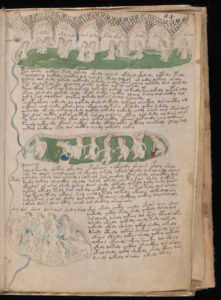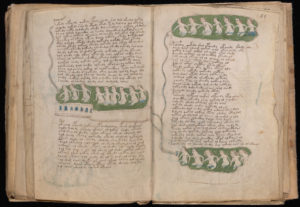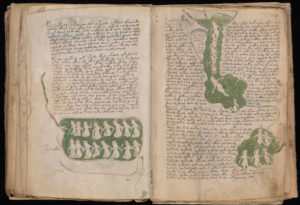Even if we can’t (yet) read the Voynich Manuscript’s inscrutable ‘Voynichese’ text, and even if many (if not most) of its bifolios appear to be misordered and misbound, there are still a handful of places where we can (I think) reconstruct its original bifolio nesting. (Despite my own intensive efforts to do this for the whole manuscript circa 2006, it seems that no codicologist has attempted to do this in any useful way in the 15 years since.)
In my opinion, these few places offer us far more structural information to help guide our search for a precursor (source) document than if we were looking at a single isolated bifolio. And if we can find a precursor document, then we (hopefully) have a what is effectively a Rosetta Stone for Voynichese: so the stakes are quite high.
In other posts, I’ve described (what Glen Claston termed) “Q13B”, which appears to be a two-bifolio illustrated balneological ‘book’ (i.e. what we would now call a ‘chapter’) misordered and misbound within the Voynich Manuscript’s Q13 (quire 13). This post attempts to deconstruct Q13B into its inner sections, to support the work of comparing Q13B with candidate treatises in future posts.
f84r
This first page of our two-bifolio set appears to depict three linked baths: the top bath level has six (probably stone) arches, the middle bath level appears elongated, while the lower bath is more broadly circular.
The top bath has some kind of piping at the left that seems to be funnelling water into it. The middle bath has three distinctive “pipe tops” or “circular pots”, which may possibly be connected to some medicinal practice. The lower bath’s second nymph from the left appears to be holding a ring or a circular object, which may again possibly be connected to some medicinal practice. The lower bath’s rightmost nymph appears to have orange-red hair.
To my eyes, the green, solid blue and solid red paint appear to be later additions, but the patchier blue, cheek rouge, and orange-red hair appear to be original colouring.
f84v-f78r
The many visual symmetries of this pair of pages strongly suggests (as I proposed back in 2006) that the two pages originally sat facing each other in the original (intended) nesting/binding order.
The pair of pages appear to be depicting a thermal bath complex made up of four natural baths, connected via some kind of (possibly terracotta?) piping. Each page appears to be made up of two sizeable paragraphs, with additional ‘label’ text attached to each of the four individual baths. Both pairs of baths appear to drain out to the bottom of their respective pages.
There is a curious unidentified detail close to the right hand edge of the lower bath on f84v (partially concealed by the ugly green paint). There is also a curious rock-like detail at the bottom-left edge of the lower bath on f78r.
f78v-f81r
This is the pair of pages that famously flagged (to John Grove many years ago?) that something tricky was going on with the bifolio order in Q13. The drawing crosses the central fold, strongly indicating that this was originally the central bifolio of a quire or gathering. It appears to depict a thermal bath complex, with a higher bath apparently with a plinth-like base (top right), a constructed bath (with seven arches), and where both baths feed into a lower bath also with a plinth (bottom right).
f81v-f75r
This pair of pages appears to depict two separate thermal baths. There is a pot at the bottom right of the left page’s bath. The right-hand page has two baths, the topmost with a vertical design and an exaggerated wolkenband at the top, possibly suggesting that it may be fed by rainwater rather than by a spring. This is connected to a smaller lower bath.
There is a large pot at the bottom of the top bath (with a nymph sitting in it); and a nymph halfway down the top bath appears to be holding a strange stake-like object.
f75v
The final page of the two-bifolio set depicts a pair of baths, the top one with an exaggerated wolkenband feeding into a horizontally elongated bath. The lower of the pair of baths appears more naturalistic.
There is a pot partially hidden behind the leftmost nymph in the top bath. A nymph in the middle of the lower bath appears to be holding a sponge, possibly cleaning another nymph’s back. The nymph at the top right of the lower bath also seems to have a very distinctive hair arrangement (not sure if this can be dated).
Q13B’s bath complexes?
Having gone through Q13B’s pages in this way, I’m struck by the high likelihood that each connected set of baths is visually representing a specific thermal bath complex. In which case, the ordered sequence of bath complexes would seem to be:
- a set of three baths, arches at the topmost level
- a set of four baths
- a set of three baths, one possibly with arched windows
- a set of one bath
- a set of two baths
- a set of two baths
Furthermore, the pot-like visual motif that appears in several of the baths also seems likely to me to be flagging some kind of medicinal usage / behaviour associated with that individual bath. Many thermal baths of the era had specific medicinal practices associated with them, so this would not be a huge surprise.





I’m pretty sure the weird line on the right was the beginning of a face, which was then abandoned. See https://voynich.ninja/thread-3339-post-45180.html#pid45180
Nick, the colour of the waters is different because in one case it is running water, while in the other it is water with herbs. Glad to help.
Great descriptive detail on pool scene descriptions, interconnectivity and the like but it is rather disappointing that the related referals to individual accompanying Q13B ‘bath’ sets are too far out of focus to be benificial in making comparitive commentary. Sorry!